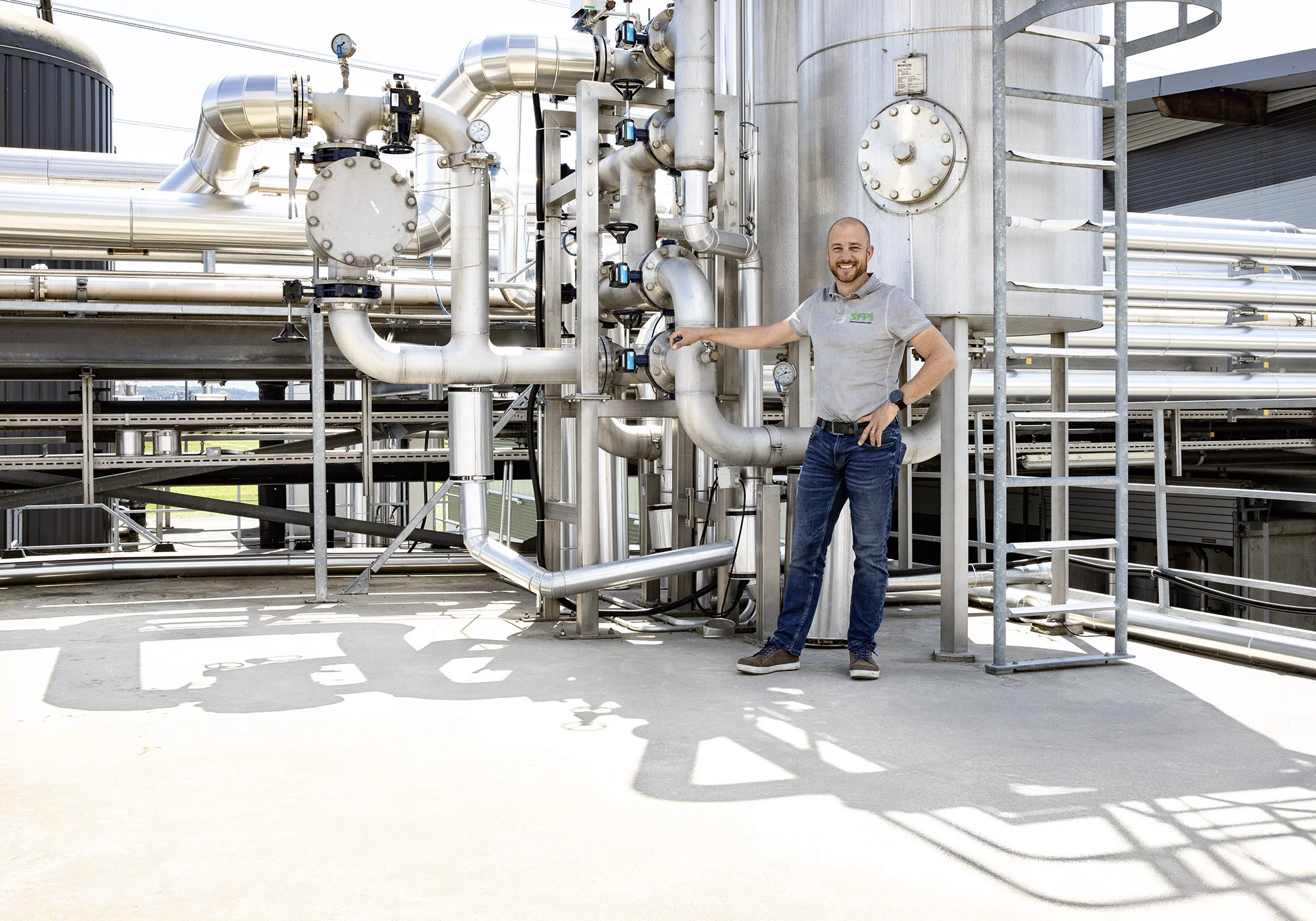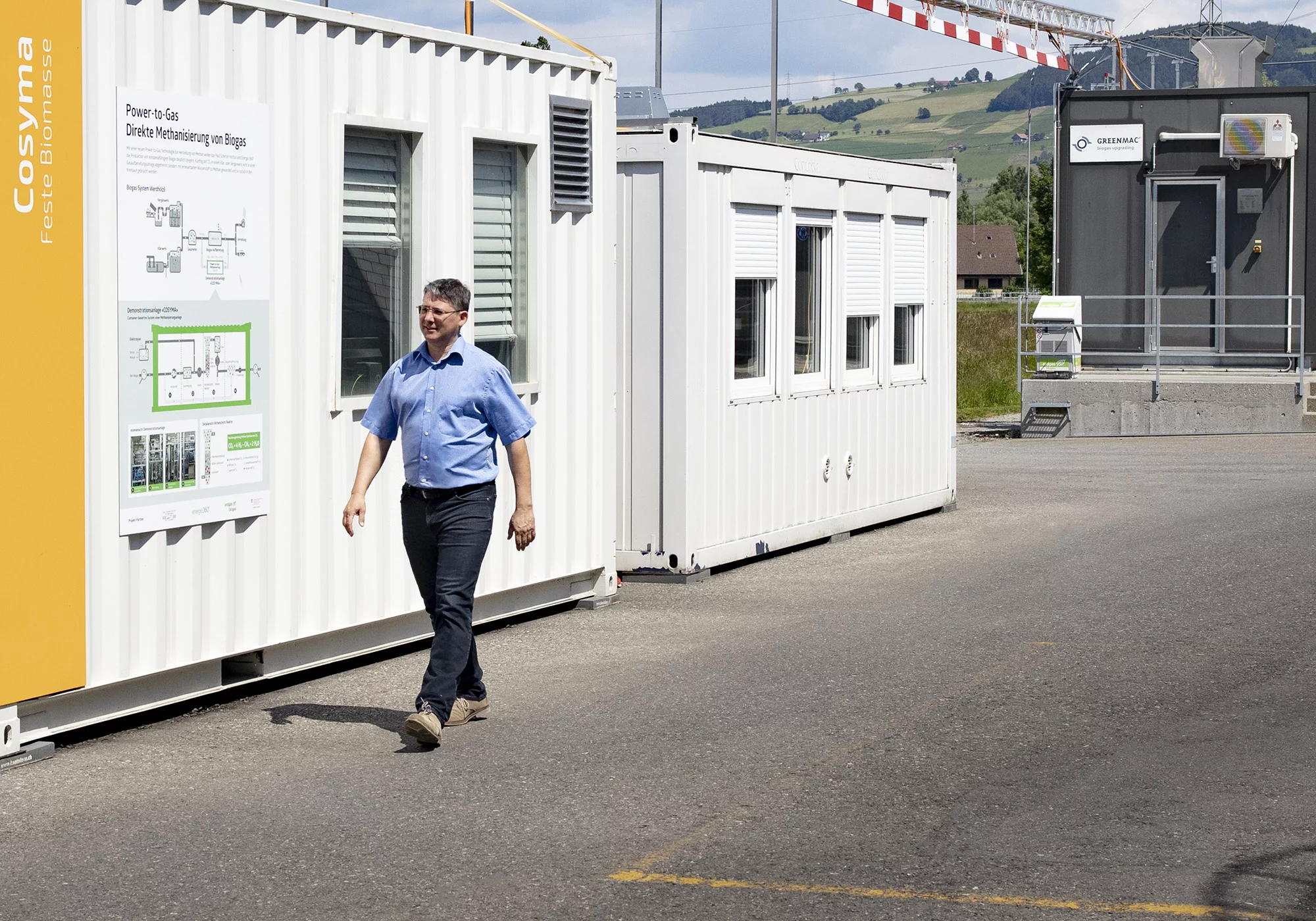PSI researchers have set up camp at a biogas plant near Lucerne. Between meadows and gigantic fermenters, they are investigating how they can remove impurities from the biogas to make this energy source even more usable.
A milk tanker rolls onto the premises of Swiss Farmer Power Inwil (SFPI), just under ten kilometres north of Lucerne. The driver gets out, clamps a hose onto the vehicle, and begins pumping dairy waste into a storage tank. Across the way, a front-end loader is moving fresh hog manure around in a warehouse. Wheat chaff and sacks of expired milk powder are also piling up there. All of it is fodder for the most important employees of the biogas plant in Inwil: the microorganisms in the fermenters, which are more than a thousand cubic metres in size. The bacteria digest the organic raw material and use it to produce biogas, among other things. This valuable energy source consists largely of methane, the main component of natural gas.
In Switzerland, bio-waste accumulates at the rate of more than 1.3 million tons per year. In over a hundred biogas plants in the country, biogas is produced with an annual output of more than 400 gigawatt hours. Swiss Farmer Power Inwil alone produces 30 gigawatt hours. The generated biomethane is fed directly into the natural gas network through an inconspicuous, ten-centimetre-thick pipe. For comparison: In 2018, Switzerland had gas sales of around 37,000 gigawatt hours.
Biomethane fed into the gas network is subject to strict quality criteria: In Switzerland, for example, it must consist of at least 96 percent methane, and a maximum of two percent hydrogen and five millionths of a part hydrogen sulphide. In order to make biomethane suitable for feeding into the network, the company first cleans the biogas with activated carbon. Then carbon dioxide, which makes up 30 to 50 percent of the biogas, is removed. This is done with what is known as amine washing: A chemical washing solution the biogas is passed through binds the CO2 and thus separates it from the remainder.
Sulphur has to go
The PSI researchers hope that raw biogas can be used even more effectively for the energy transition in the future. However, the biogas contains many other impurities that could be important for future applications. The aim, therefore, is to precisely analyse the composition of the raw biogas and to remove even the smallest amounts of contaminants effectively and as economically as possible.
"Organic sulphur compounds give us the most headaches," says engineer and PSI group leader Serge Biollaz. These compounds, along with hydrogen sulphide, are formed when bacteria break down proteins that contain sulphur atoms. Up to now, these and other contaminants have prevented biogas from being used, for example, in a fuel cell. Fuel cells produce electricity from energy-rich gases such as hydrogen or methane. But sulphur compounds are pure poison for them. That’s why fuel cells can't run on biogases – as produced in Inwil – at the moment.
“We want to answer the question, right on site, of how we can get biogases clean enough for various end uses," says Biollaz. "In this case, it should be pure enough for a fuel cell." For this, the gas is allowed to contain a maximum of a half-millionth part of sulphur compounds. That is just a tenth of what is permitted in the biomethane that SFPI feeds into the natural gas network. For this purpose, part of the ESI platform, short for Energy System Integration, was transported to Inwil. This PSI experimental platform enables researchers to investigate renewable energy alternatives in all their complex interplay.
A container housing the Cosyma research system was set up on the SFPI site, and another one with gas analysis measuring devices next to it. "That was part of the ESI concept from the start," explains Biollaz. "Individual modules were stored in containers precisely for this reason, so that they can be used flexibly on site, as was the case in 2017 at the Werdhölzli fermentation and sewage treatment plant in Zurich."
How biogas plants can benefit
Together with the start-up UniSieve, a spinoff from ETH Zurich, the PSI researchers in Inwil are also testing a new separation method to remove carbon dioxide from biogas: A new type of membrane from UniSieve is expected to separate CO2 and methane on the basis of their different molecular sizes – like a sieve. If this also works in practice, it could further reduce the costs of producing biomethane.
The bacteria in the fermenters are given many different substrates for fermentation. So it's no wonder that the composition of the biogas is quite variable. "Often there are unpleasant surprises," explains Philip Gassner, managing director of SFPI: Depending on daily conditions and what the bacteria are fed, the biogas may contain first too much carbon dioxide and then too much hydrogen sulphide.
If the quality of the biomethane is not good enough for the supply, the tap shuts automatically, and we can no longer feed any more into the natural gas network," Gassner says. "But biology keeps on going." Then SFPI has no choice but to burn the valuable biomethane. That's because methane must not be allowed to get into the atmosphere: It is even more damaging to the climate than the carbon dioxide produced when it is burned. "We hope to better understand, with the help of the PSI researchers, what is happening with our biogas in the course of formation and processing." This could ultimately benefit all of the country's biogas plants.
From the laboratory to real life
Serge Biollaz enters the first of two ESI containers on the SFPI grounds. Here the biogas flows through two reactors, one after the other. In the first reactor, hydrogen sulphide is removed along with terpenes, which are natural hydrocarbons. Organic sulphur compounds including dimethyl sulphide, which, according to Biollaz, "causes a lot of problems and is difficult to remove", should be eliminated in the second reactor. Dimethyl sulphide is a highly prevalent compound on the earth, since it is also formed by phytoplankton in the ocean. This sulphur compound, too, is pure poison for a fuel cell.
The biogas should even be clean enough for a fuel cell.
In their laboratories at PSI, the researchers have collaborated for years with industrial partners in a detailed search for potentially suitable sorbents that are especially effective in removing impurities as well as capturing the broadest possible range of contaminants. "We don't want to have to start from scratch at every site," Biollaz explains. What works in Inwil should also work in other biogas plants in Switzerland and with different biogas compositions. The researchers are currently testing a zeolite, a porous silicon- and aluminium-containing material that can absorb and hold on to organic sulphur compounds.
In the laboratory and at the ESI platform, no genuine biogas is available to the researchers. Instead they blend bottled gases together to create a mixture as similar to the real thing as possible. "Naturally, that is something different from what an actual, operating biogas plant can provide. The situation here in Inwil is special because the plant converts so many different substrates," says Julian Indlekofer, a member of Biollaz's group who is also taking measurements on site in Inwil. On the basis of the insights they gain here, the researchers then want to optimise the purification of the biogas – to the point where it is even clean enough for a fuel cell.
Text: Brigitte Osterath
Copyright
PSI provides image and/or video material free of charge for media coverage of the content of the above text. Use of this material for other purposes is not permitted. This also includes the transfer of the image and video material into databases as well as sale by third parties.



